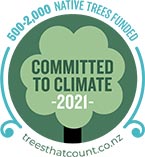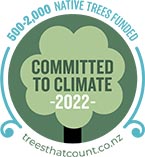Trees That Count
We're painting a greener future

Resene Eco.Decorators are proud to support the Trees That Count programme to help regenerate New Zealand's native bush through the planting of native trees.
To date Resene Eco.Decorators have donated 5,550 native trees estimated to remove approx. 1,263K tonne of carbon dioxide, in addition to the 17,628 native trees that Resene has provided estimated to remove approx. 4,012K tonne of carbon dioxide.
Trees donated by Resene Eco.Decorators have helped support these planters:
Ngai Tupoto ki Motukaraka Trust
Ngāi Tpoto ki Motukaraka is a hapū trust undertaking native revegetation projects in the Hokianga Harbour. Trees That Count is supporting the Manawatawa Native Replanting Project which aims to restore about 25ha of hill country on the Hokianga Harbour in Motukaraka.
An area of 1200 ha was taken from the Ngāi Tūpoto hapū by the Government in 1885. 40 ha was returned in 2015 as part of the Te Rarawa settlement. A plan has been developed including housing, a nohoanga, a social enterprise hub, a water scheme and restoration of native bush. From 1907 to 1958 the Hokianga Dairy factory operated from the site. The legacy of that development is a dam, which is being developed into a community water supply to increase resilience from droughts.
The catchment includes some regenerating native bush and an area of wilding pine that has now been removed. The native replant will restore the water catchment to native bush, improve the water quality and restore bio-diversity. A flora survey has been carried out and there are around 165 native species present, some threatened and rare. The area is a kukupa habitat and home to many species of native fauna. The land area is steep in parts and prone to weed infestation.
The project started in 2021 with nearly 5000 trees being planted and weed control work undertaken on about 7 ha. In 2022 we plan to complete planting and weed control work on another 13 ha. The land is under the Ngāi Tūpoto ki Motukaraka Trust; a hapū trust with charitable status. This project is part of a rohe wide approach to improving environmental outcomes.
The Longbush Ecological Trust
The Waikereru Ecosanctuary is a haven for rare and endangered species of native birds, plants and animals. It is reached by a winding gravel road up an inland valley, just 9 kilometres from Gisborne city on the Tai Rawhiti / East Coast of New Zealand.
From high hill ridges to the west, three streams tumble down steep valleys and across a plain, entering the Waimata River to the east. A rare surviving strip of lowland bush (Longbush Reserve) runs beside the Waimata River. The bush is alive with the sound of birds, including tui, bellbirds, fantails, kingfishers, whiteheads and many kereru or native pigeons.
Waikereru Ecosanctuary is a fine example of ecological restoration in the Tai Rawhiti district, whose biodiversity is at extreme risk from land clearance, erosion and introduced plants and animals.
The project being supported by trees That Count will use 'seed islands' designed by David and Michael Bergin from Project Crimson and Mark Smale from Landcare Research to accelerate the regeneration of biodiverse native forest in the hills at Waikereru Ecosanctuary. The idea is to clear lightwells in regenerating manuka-kanuka shrublands on steep, highly erodible slopes to plant a succession of shrubs and trees to attract birds that will disperse seed throughout the shrublands, thus speeding up the regeneration of biodiverse native forest. This trial of 'strategic regeneration' builds on earlier trials on the Cyclone Bola slump foothills, that were very successful: https://pureadvantage.org/restoration-need-not-cost-the-earth/. Our aim is to show that strategic regeneration can contribute to tackling Aotearoa New Zealand's climate change, biodiversity loss and waterway degradation crises in a cost-effective, ecologically intelligent way.
Tasman District Council
For generations we thought wetlands suck, so we drained them. Now we know they do suck..... carbon, disease causing organisms, sediment and pollutants. Wetlands are the kidneys of our catchments.
This project has two main objectives:
-
The restoration of approx. 40 existing natural wetlands that are degraded to remove weeds and improve biodiversity / ecological values.
-
The creation of seven new constructed wetlands to improve downstream water quality, in-stream habitat and summer low flows.
By controlling weeds, replanting, restoring natural hydrological regimes and creating new wetlands, this project will improve the health and resilience of native wetland vegetation communities and the biota they support; downstream improvement in water quality, in-stream habitat and summer flows.
Tasman District Council have initiated the project and received funding from Jobs for Nature to continue the great mahi already underway across Te Tai Ihu, by collaborating with iwi, community, NGOs and Department of Conservation. This legacy project will create not only lasting ecological and cultural wins but provide employment for Covid affected people and learning opportunities for rangitahi and tamariki.
The Nature Conservancy - Kotahitanga mō te Taiao Alliance
The Nature Conservancy is a partner of the Kotahitanga mō te Taiao Alliance, with all iwi, Councils, and the Department of Conservation working across 2.5 million hectares of the Te Tauihu/Top of the South Island, including Buller/Kawatiri, Tasman/ Te Tai ō Aorere, Nelson/Whakatū and Marlborough/Wairau. The Alliance works collaboratively to achieve shared conservation goals to ensure both people and nature thrive, from a robust strategic plan that identified key threats to the region's ecosystems, including invasive weeds and fragmented landscapes. The Restoring and Protecting Flora Project is delivering strategic weed control across 17,000 hectares in areas of ecological importance on public, Māori, and privately-owned lands across the region.
The Trees That Count sub-project's restoration planting will complement the weed control efforts already funded by a $6m grant from DOC Jobs for Nature, a crucial next step in a wider restoration regime that will add resilience to these ecologically sensitive and valuable sites. Leveraging the project's already-funded labour by experienced contractors, we will use the requested funding to plant native trees at key sites in Buller, augmenting long-term weed suppression and improving connectivity and buffering of fragmented sites, which will be prioritised to ensure the plantings are maintained. We will plant over 10,000 trees - predominately hardy, fast-growing species, enhanced with diverse enrichment species (exact species and numbers to be determined on a site-by-site basis). All trees will be eco-sourced locally from suppliers with proven track records (including Clean Streams Karamea). Indicative sites include West Coast estuaries: Westport's Floating Basin, Mokihinui, Little Wanganui, and Oparara.
Mana Tahuna Charitable Trust - Te Wai Whakaata
Mana Tahuna Charitable Trust is a charity organisation that has a vision to have a united Māori community in Tāhuna (Queenstown). Our mission as an organization is to improve the overall wellbeing and livelihood of Māori and Pasifika people within the Tāhuna community. One of our values is kaitikitanga, the guardianship and protection of the whenua (land) and taiao (environment). We are all closely connected to the whenua and have witnessed its degradation in Tāhuna. At Mana Tāhuna we want our kaimahi (workers) to be kaitiaki (guardians) so our tamariki (children) can enjoy a restored whenua in the future.
Mana Tāhuna Charitable Trust is working on a large-scale restoration project in the Lake Hayes catchment to clean the water quality of the tributaries and lake, improve the biodiversity of the area, and introduce native habbitat. This project looks to achieve this goal through planting tens of thousands of native riparian plants and trees along the side of the rivers and in wetlands in order to: - stablise the bank allowing natural slowing of the river and the retention of sediment, and phosphorous E.coli, therefore reducing that which reaches the lake - create a natural habitat for native birds and insects that will reinstate the ecosystem that once stood there. In support of that we will additionally be: - instating 150 hectares of predator trapping to allow the native birds and insects to flourish - implementing and maintaining sediment traps throughout the catchment, and rebuilding banks Notable benefits will be the return and increase of native species to the area, and reduction of toxic algae blooms in the lake, which will return the area to the healthy nature reserve and recreation area that it once was.
Wild Waikawa - Protecting Papatūānuku
Papatūānuku is responding to our conservation efforts on this significant 500 acre parcel of land at the headwaters of Waikawa Stream, Waikawa. Mauri is rising with the removal of 700 animal pests, 7000 wilding pines, 300 wasp nests & planting 1500 eco-sourced plants and trees. Our hope to support bird, insects and invertebrate to repopulate is strong. After two years of mahi, we have already observed birdsong doubling, seedlings emerging and existing mature trees foliage thickening.
We have the active support of our local community with Te Atiawa Iwi, Waikawa Marae, Marlborough District Council, Department of Conservation, Picton Dawn Chorus, and Picton/Waikawa/Blenheim school groups from kindergarten to College including Maori, Environmental & Science teachers. Recent grass roots community events including trap distribution and planting trees for future generations with a diverse age groups of 5yrs to 75years+ was incredibly uplifting as we all worked together for nature. Our inclusivity will continue as we believe community purpose towards nature restoration breathes wellbeing and life for us all.
Our next goal is to plant trees who grow 20-50metres (Tōtara, Rimu, Southern rātā, Miro, Matai) in amongst already existing regenerating trees (mānuka, kanuka, mako mako, rangiora, whauwhaupaku), starting along the Waikawa Stream riparian margin. This will speed up biodiversity, replacing lost forests due to deforestation some 60 years ago, as well as replacing dead trees from goat and possum browsing. This area is approximately 6Ha along 2kilometres of Waikawa stream with approximately 1 plant every 5m2 and some 2400 plants to be planted in 2023.
All our efforts will increase bird populations, water quality & microinverterbrate health and support a healthy 3-4km wildlife corridor encompassing te maunga Piri Piri & Mt. McCormick along the two Waikawa streams through to Picton and Waikawa. All of our mahi will impact from our highest mountain to sea for generations to come. Thank you for any support given to restore Papatūānuku. ngā mihi Nige & Mish.
Rotary Club of Taradale - Dolbel Reserve Restoration Project
The Rotary Club of Taradale was established in 1959 and, in partnership with Napier City Council since 1992, have developed 18ha of scrub covered hill called Dolbel Reserve on the outskirts of Taradale into a native tree reserve. Dolbel Reserve is rare in an urban environment and is well used by people of all walks of life, both local and visitors, school groups and clubs and are a valuable community asset for Hawkes Bay people and visitors. In 2005 Rotary Club of Greenmeadows joined the partnership and developed the Colenso Block and Bell Block on the southern slopes.
Over the years the Rotary Club of Taradale created numerous tracks, opening up access to many areas of sloping land and planted 1000s of native trees and native plants such as flaxes and ground cover. Our Dolbel team comprises a total of 16 volunteers with four being members of Rotary Taradale with the others being friends of Rotary. Our primary work day is on Tuesday mornings for approximately four hours, although a number of our team go to these reserves extra days during the week to plant, weed and water the plants and trees as necessary. This extra work has ensured the growth and survival of the more recent plantings which is evident by few losses due to the drought. Last year we planted over 2000 trees to celebrate 100 years of Rotary in NZ as part of Rotary's Forests of Peace and remembrance project.
Tairāwhiti Ngutukākā (East Coast Kakabeak)
If it wasn't for Graeme Atkins, ngutukaka would most likely already be extinct in the wild. With less than one hundred plants remaining, he founded the Tairāwhiti Ngutukaka project, with a vision for our mighty east coast to once again flourish with the colours of ngutukākā in the wild, as it did in the days of our tīpuna. We plant, protect and care for wild and cultivated ngutukākā (a.k.a. kākābeak and clianthus maximus) around Te Tairāwhiti, home of this taonga species. We share our mātauranga, knowledge, information and passion for ngutukākā to ensure ngutukaka not just survives but thrives in the future. We plan to make Tokomaru Bay the ngutukaka capital of the world and are on track to plant thousands of ngutukaka in and around the rohe for all to enjoy, working directly with our kura and tamariki to educate, inspire and empower kaitiaki tamariki, our leaders of āpōpō.
Hauraki Islands Forest and Bird
Hauraki Islands Forest and Bird does biodiversity and restoration work across our four reserves on Waiheke Island covering an area of 120 hectares. We also do community outreach in schools, work on Council projects and support other organisations.
One area of focus is Pukerakau, which was given to the branch with an understanding that the existing old growth forest would be supported by reforesting the surrounding paddocks. A large majority of this has been completed, with around 5000 trees already planted. There are still 2 large areas that require planting. This planting is significant as it supports some of the last older growth forest pockets that exist on waiheke island. These forests pockets provide habitats to rare birds such as the kaka.
Onetangi Forest, which is protected, owned and managed by Forest and Bird Hauraki islands is another focus of ours. It is a significant ecological area with wetlands and old growth forest. There has been large scale reforestation over the last 50 years to support the old growth forest.


For more information on Trees That Count and to find out how you can help more native trees be planted in New Zealand, visit the Trees That Count website.

